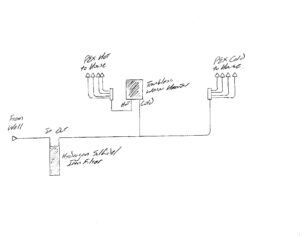Basic Description of Plumbing
Plumbing involves the installation, repair and maintenance of a system that brings fresh water into a building and removes waste water out. It is an important part of any building and needs to be functional and safe. The plumbing industry is regulated at the state and local levels by governments. The trade is also regulated by professional organizations that set standards for training and certification.
There are three different types of plumbing: sewage, water and drainage systems. Plumbers are trained to work with all of them. Plumbing includes a wide range of skills that allow an individual to work with water and waste disposal, including the use of tools, pipe sloping, water pressure design, overhead and underground piping. It is important for plumbers to have good communication skills because they often have to explain technical issues to customers.
The earliest plumbing was probably the system of clay pipes used to transport water and waste in Mesopotamian cities around 4000 BCE. These were later replaced by metal pipes. The plumbing of the ancient Romans was more sophisticated with extensive systems of aqueducts and tile wastewater removal. But as the population grew and cities became more crowded, conditions worsened and outbreaks of diseases such as typhoid fever and dysentery occurred. It was not until the 19th century that significant improvement was made with separate plumbing systems for drinking water and sewage.

What is the Basic Description of Plumbing?
Modern plumbing is based on scientific principles that have been developed over the years. It is a complex system but the basics are simple. For potable (drinking) water, we need clean, fresh ground or surface water. This must be supplied under pressure to reach all parts of the house. It must also be heated if it is to be usable for cooking and washing. For waste water, we need a way to take it away without causing disease or discomfort.
The basic plumbing system consists of a series of pipes, fixtures and appliances that carry water to and from each room. The pipes are usually buried in the walls and ceilings, but they may be exposed in some cases. The fixtures include sinks, bathtubs, toilets, showers and faucets. The piping is connected to the fixture by fittings. A valve on each fixture is used to control the flow of water and to shut it off in an emergency. The main water supply pipe is controlled by a meter and is usually located near the meter. A main water shut-off valve is also important in case of emergencies. This can be closed quickly to prevent flood damage. Other specialized plumbing equipment includes water heaters and backflow preventers. Water filtration systems, UV sterilization lights and specialty roof hatches are also used. These are used for both domestic and commercial buildings.
Polyvinyl chloride, commonly known as PVC, is a versatile synthetic polymer widely used in various applications, and one notable use is in plumbing systems. PVC plumbing systems have gained popularity due to their durability, cost-effectiveness, and ease of installation. This material has revolutionized the plumbing industry, offering numerous advantages over traditional materials like copper or galvanized steel.